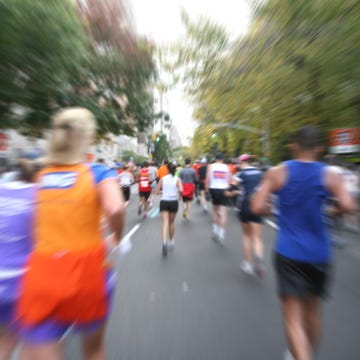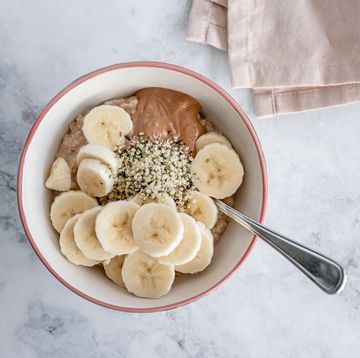A new systematic review has revealed the best way for ultrarunners to fuel their training and racing while minimising unpleasant gastrointestinal symptoms.
The answer, the review says, is to eat a diet low in FODMAPs, which stands for Fermentable, Oligo-saccharides, Di-saccharides, Mono-saccharides And Polyols. These are carbohydrates that do not get fully digested or absorbed in the gut, and for those with a sensitive bowel can cause symptoms, such as gas, bloating, stomach pain, nausea and diarrhoea.
The low-FODMAP diet was first developed by researchers at Monash University in Australia, whose pioneering research studies revealed, for the first time, how the diet can reduce symptoms in people with Irritable Bowel Syndrome (IBS).
What everyone's reading
During endurance running, a number of pathways can trigger IBS-like symptoms, which are called exercise-related gastrointestinal symptoms or GIS in scientific literature. These pathways are physiological, mechanical, psychological and nutritional – and can be exacerbated by the extreme environmental conditions in which ultra-distance races take place, such as high heat, humidity and altitude.
Symptoms are not only unpleasant but, according to this systematic review, published in Nutrients, are potentially the most common cause of underperformance during endurance events – estimated to affect between 30 and 90% of athletes.
Endurance athletes have long employed and experimented with a variety of nutritional strategies to manage gastrointestinal distress. However, the data on such practices within an ultra-endurance population hasn't yet been compiled, making it a challenge for sport nutrition professionals to develop supportive recommendations.
In the review, researchers explored seven existing studies, comprising 105 participants (50 male, 55 female), looking at nutritional strategies used before, during or after endurance sport in an attempt to alleviate exercise-induced GIS in ultra-endurance athletes.
It found that following a diet low in FODMAPs leading up to and during exercise – as well as throughout the recovery period – has the potential to support ultra-endurance athletes in reducing exercise-induced GIS. One of the reasons is because these foods create osmotic pressure, and as a result water is forced into the gastrointestinal tract. Additionally, they are easily fermentable in the colon and subsequently increase gas production. This can cause symptoms including bloating and discomfort.
Perhaps unsurprisingly, the review found that carbohydrates may be more favourable as an energy source during ultra-endurance training and racing – and that supporting carbohydrate tolerability via gut training 'w0uld be extremely beneficial' for long-distance runners. However, findings regarding the precise carbohydrate blend for optimum performance effects with minimum GIS incidence were inconclusive.
Moreover, researchers also looked at the impact of medium-chain triacylglycerols (MCTs) – these are shorter-chain fatty acids high in foods such as cow's milk and coconut oil. It found that a high intake of MCT may be detrimental to performance due to its impact on GIS prevalence, but small amounts didn't have any obvious effects.
The research also looked specifically at the impact of including dairy milk (a known FODMAP) within a pre-exercise meal but concluded that this didn't appear to improve or reduce GIS symptoms, explaining 'the potential of dairy-rich pre-exercise meals to enhance or impair gut comfort during prolonged exercise remains unclear'.
While FODMAPs are found in a wide variety of foods, substituting high-FODMAP foods with low-FODMAP alternatives is surprisingly straightforward.
For example, while carbohydrate sources such as breakfast cereals and wheat-/rye-/barley-based breads are high FODMAP, there's many low-FODMAP carbohydrate alternatives, including oats, rice, potatoes, quinoa, sourdough spelt bread and wheat-/rye-/barley free- breads.
As for dairy products (and alternatives), although cow's milk and soy milk (made from whole soybeans) are high FODMAP, soy milk (made from soy protein) and many dairy-based cheeses are low FODMAP, such as brie, camembert, feta and hard cheeses.
Meanwhile, protein sources that are high FODMAP include most legumes and some processed meats but eggs, firm tofu, cooked meats/poultry/seafood and tempeh are all low FODMAP.
As for vegetables and fruits, high FODMAP examples include onion, garlic, peas, apples and watermelon, while low FODMAP fruits and veggies include aubergine, green beans, carrot, cucumber, madarin, orange, pineapples and blueberries.
You can find out more about high- and low-FODMAP foods via the Monash website, as well as its app, which uses a simple traffic light system to rate foods as low, moderate or high in FODMAPs.
It is essential to consult with a dietitian before commencing a low-FODMAP diet. This is especially important for runners and ultrarunners, who need to ensure an adequate intake of calories to meet their high energy demands, including a sufficient intake of carbohydrates to fuel training and recovery.

Jen is Membership Director at Runner’s World, overseeing RW’s new membership programme, set to launch later this year. She has been with the brand for close to three years now – previously working as deputy digital editor, where she covered all manner of running topics, spanning training, health, injury, nutrition and gear. Over the years, she’s interviewed an abundance of awe-inspiring athletes, from top-tier ultrarunners and Olympic champions to everyday runners who have accomplished extraordinary things. Jen has been a sports journalist for 10 years; she is the former editor of Women’s Running magazine and has also worked as Sports Editor at Red Bull. She started running a decade ago and likes to dabble in triathlon a little, too. You’ll find she’s happiest plodding down the Thames path or chowing down on a post-run pastry.













